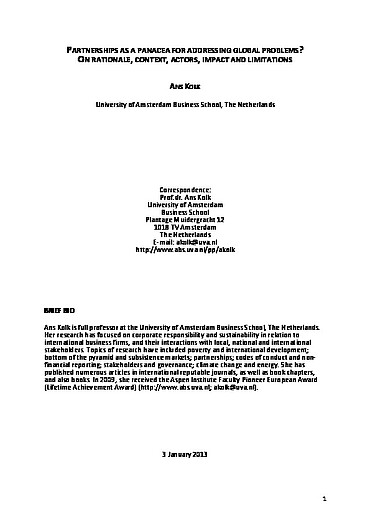Abstract
This chapter examines partnerships and their peculiarities, based on recent research from various disciplines, in the context of the large problems faced by (global) society. These problems are very complex, often cross national boundaries, and cannot easily be 'solved' by one single actor. Previous 'unilateral' attempts to address them have not been particularly successful, and there are limits to what a single actor can do. Cooperation also enables different actors to leverage their resources and know how. It is therefore that the past decades has seen a rapid growth and spread of several types of cross-sector collaboration: public-nonprofit; public-private; private-nonprofit; and tripartite partnerships involving government, companies and non-governmental organizations (NGOs). The chapter first gives an overview of the rationale for cross-sector partnerships, and the advantages of partnerships for different actors involved. This is followed by an discussion of the complexity and diversity of contexts in which collaborative activities take place, and of the actors themselves, from a 'global-to-local' (development) perspective. Some of these aspects have been explored in the management literature, but deserve more attention in research and in the practice of partnerships. What has been examined somewhat more, although without a definite answer so far, is the effectiveness of partnerships in relation to the larger problem(s) to be solved. Some of the difficulties of assessing 'impact' will be indicated, accompanied by recent insights, considering different levels (macro, meso, micro) and roles of partnerships. Reflections on limitations and recent trends – including a possible move beyond partnerships – will be offered as well.
Citation Note
In: M. Seitanidi & A. Crane (Eds.) (2013), Social Partnerships and Responsible Business: A Research Handbook, Routledge
